© 2025 ALLCITY Network Inc.
All rights reserved.

The Denver Broncos came into the offseason needing to add more talent on the offensive line, and with the additions of Ronald Leary from the Dallas Cowboys and Menelik Watson from the Oakland Raiders, they’ve done that. At this point, though, it remains unclear to what extent. As of now, the two seem like the only additions Denver will make to the line this offseason, at least until the draft.
Leary and Watson’s acquisitions in free agency have been met with differing reviews and many of the same stats being thrown around to explain the value of these two big-money key signings for Denver.
Because of this, we had to dig into the film and find out who they are, what their addition to the lineup means for the Denver offensively, and what these guys really bring to the team beyond their Pro Football Focus grades.
Ronald Leary
As the Broncos first signing in free agency, the former Cowboys left guard comes at a big price for an interior lineman, becoming one of the highest-paid guards in the NFL with an average salary of $9 million per year. That’s a big singing, and the Broncos did it because Leary is supposed to be a significant upgrade at guard.
Denver’s new highest paid bruiser brings the “attitude” that head coach Vance Joseph spoke of in his introductory press conference as a road grader in the run game. Not the most athletic and he won’t amaze you in space but he’s a proven power blocker who creates big holes for backs and will toss guys around with an edge. He’s also surprisingly quick downhill getting to the second level where he’s a very efficient blocker.
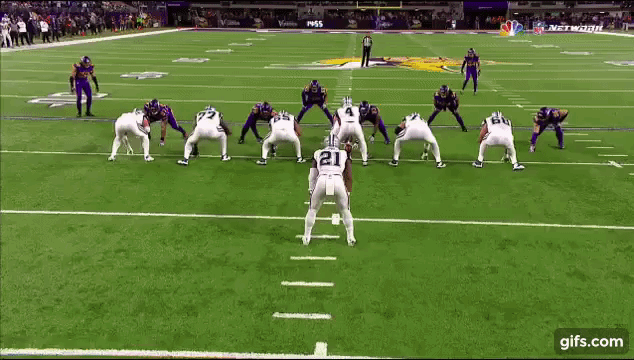
The 27-year-old former Memphis Tiger is absolutely a high-level run blocker and is also a destroyer in short yardage and goal line situations, much thanks to his power. He was graded as the 14th-best run blocking guard by PFF with a score of 82.5 while starting 12 games for Dallas last season. Leary was PFF’s 24th ranked guard overall in the NFL and allowed no sacks in 2016, though he did get flagged for two false starts and two holds.
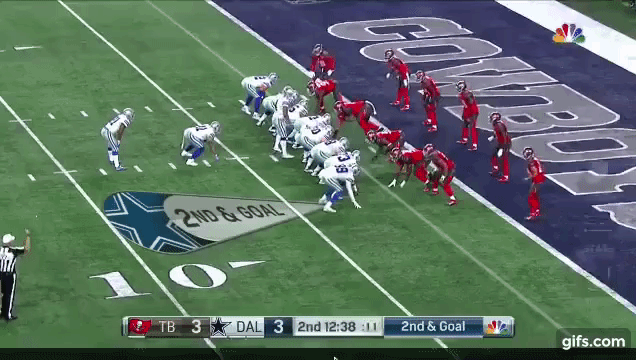
As a pass protector, Leary uses his power well to anchor and block with good balance. He has powerful hands and does a nice job once he gets a hold of a defender, rarely allowing them to escape. He also has powerful hips that he can use to finish guys off when double teaming players in pass pro. On tape, he stands out for how assignment sound he is picking up extra pressure and often pointing out things pre-snap.
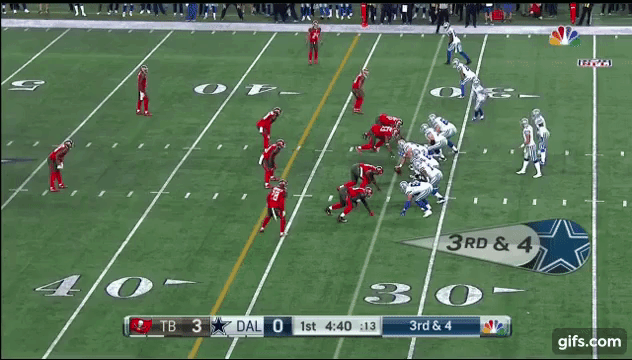
He does, at times, struggle with smaller twitchier defensive tackles in one-on-one situations, he can get beat off the snap by quicker athletes and will also be susceptible to counter moves. His flexibility isn’t superb, and guys will slip under his pads from time to time. This is a big reason why he’s allowed 12 career sacks in 47 starts and has also been flagged for nine holding penalties.
His power and strength in the run game make him a potential fit at right guard as well, though he would be tested facing more on one-on-one blocks as a center’s protection often shifts to the left guard side in most formations. In his NFL career, he’s exclusively played as a left guard, but he has the traits to play on the right.
Leary is a big upgrade to what the Broncos already had on the roster at the position, and you can see why he was an important target for the team this offseason.
He’s a noticeable switch from what Gary Kubiak was looking for in his zone-blocking scheme as he’s ideally suited in a power scheme.
Menelik Watson
Watson’s signing was greeted with much more skepticism and doubt as few people are truly familiar with the part-time starter. One person who is familiar with Watson is former Oakland offensive coordinator and new Denver quarterbacks coach Bill Musgrave who used Watson in 10 games last seasons starting him five times.
While the numbers might not be eye-popping, Watson was a very valuable piece for Musgrave starting at right tackle at the beginning of the season and even being used at left tackle, sometimes within the same series. That versatility is the first selling point to the Broncos new signing who’s receiving an average base salary of $6 million on his new three-year contract.
First things first, we should address the elephant in the room. Menelik’s signing wasn’t greeted with much enthusiasm as the answer at tackle for a squad that’s in desperate need of improved blocking from their bookends. In 17 games as a starter in his career, he’s allowed six 6 sacks and been flagged for eight holds. This past season, he allowed one sack and was guilty of three false starts while receiving a 49.4 grade from Pro Football Focus good for 56th best amongst tackles in the NFL—for reference sake, that’s significantly worse than Russel Okung’s 73.5 but much better than Ty Sambrailo and Donald Stephenson’s, 34.7 and 28.0 respectively.
While he’s not an improvement on what Denver had at left tackle in 2016, he is better than the options the Broncos had on the right side last season, and while watching tape of Watson, this was clear to see.
As a raw prospect coming from Florida State with limited football experience and huge upside—a former boxer in England—I remembered Watson and went back to watch a little college tape. The strides he’s made are impressive. His technique, hand usage, his recognition and ability to pick up extra rushers have all greatly improved from his college tape in 2012. He shows great lateral mobility doing this too.
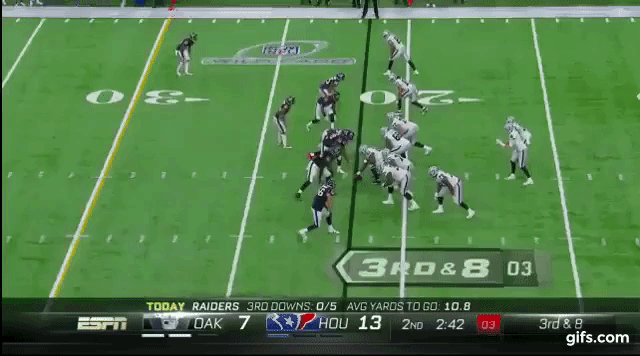
As a run blocker, Watson is an athlete first and foremost, this is evident when he has a head of steam or is asked to pull or get out in space to block on a screen pass. His movement skills are impressive and he’s a very efficient run blocker with some power to his game when in space. He certainly looks the part and has also shown a nice use of angles, as he’s very good in sealing off lanes for big gains.
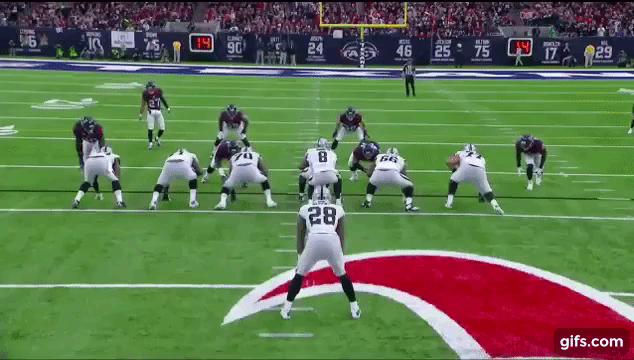
His power at the point of attack and hand usage needs ironing out. Making him much less impressive in-line than he is in space or with a head of steam. He certainly strikes as a better fit in a zone-block scheme when it comes to his performances against the run. Though he does show some nice power form at times. Technique and hand usage just need to be more consistent, an issue for him in all areas.
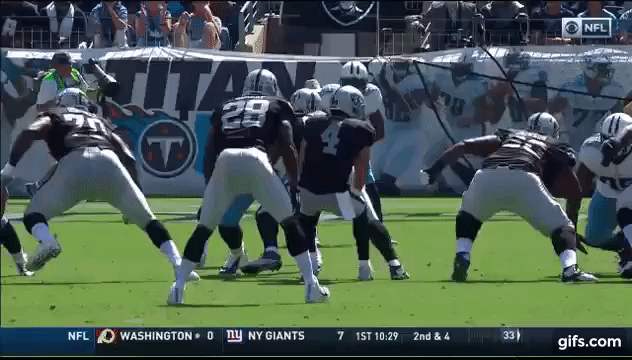
Watson in the power-heavy scheme that the Raiders used wasn’t considered to the level of Austin Howard as a run blocker, who started the majority of the season, but he was seen as the better pass protector. Thanks to his athletic gifts, he has some outstanding talent in pass protection. He does use his hands well in the video below, though his initial punch could be more powerful—for a former boxer you’d expect more—and his lateral mobility stands out here too. Especially when setting wide, he does a nice job and when he uses proper technique, he’s very talented in pass protection.
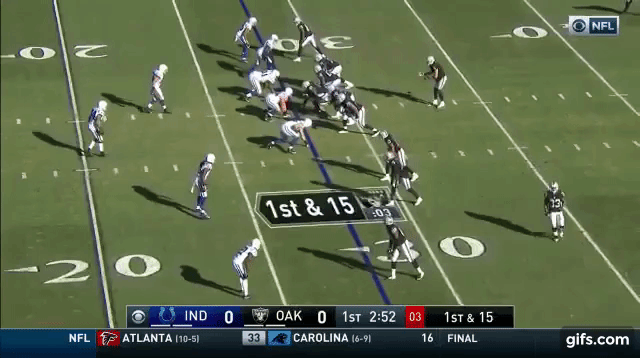
On the other hand, he doesn’t always initiate contact, and his kick-slide is a bit choppy and becomes a rushed backpedal when he rushes things. When he does this, top pass rushers are able to exploit him, something that was evident when he went against Von Miller and Jadeveon Clowney. This was abundantly clear when Watson was forced to play left tackle in the Wild Card round and in Week 17 for small stretches as Donald Penn battled injuries.
Overall, his versatility, athleticism and the fact that he still has room to improve (which you can’t say about many offensive tackles in this free agent cycle) make him a very intriguing pick up. His ability to be used on the left side in a pinch is also a valuable asset adding more competition to the left tackle spot in training camp. If healthy, he’s clearly an upgrade over the Broncos current crop of tackles, but he’ll have to stay healthy—he’s only started 17 games and appeared in 27 in four seasons, largely due to injuries—and will need to improve some inconsistencies to be a quality starter.
How they fit
While it might have been a disappointment for the Broncos to have lost Russell Okung and not found a true replacement at left tackle, Leary and Watson are important improvements at left guard and right tackle. It’s also worth remembering that the offensive line is a five man unit and just one upgrade can make everyone better.
Denver’s new coaching staff has talked about being more diverse in their blocking scheme, mixing in a lot more power to the zone formations that were much more prevalent last season. That’s clear with these two new acquisitions, though it’s interesting to note that Leary seems more adapt to a power block while Watson is better suited to a zone. In addition to center Matt Paradis, who is ideal in a zone—much like Sambrailo and Stephenson—the Broncos will have lots of decisions to make as they try to maximize the everyone’s strengths.
For now, they’ll have to exploit Watson’s versatility and upside while utilizing Leary’s power in the run game. If healthy these should be significant acquisitions for a line that will likely add at least another member in Aprils Draft.
Comments
Share your thoughts
Join the conversation




